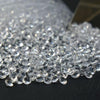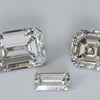
Moonstone vs Rainbow Moonstone: Understanding the Differences
Moonstone and rainbow moonstone are both captivating gemstones with a rich heritage and aesthetic appeal. If you're intrigued by the subtle shimmer of these stones, it's essential to understand their differences to make an informed decision for your collection. Moonstone is a member of the feldspar group and is cherished for its adularescence, a phenomenon where light scatters across the stone, creating a glow reminiscent of moonlight.
Big Savings on Rings – Luxury Designs, Friendly Prices!
Rainbow moonstone, despite its name, isn't technically a moonstone but a variety of labradorite, which is also a feldspar mineral. This gemstone displays a mesmerizing play of colors known as labradorescence, which should not be confused with the moonstone's adularescence. The rock crystal quartz base in imitation rainbow moonstones can sometimes exhibit a multicolor iridescence, which makes them a skillful imitation.
Composition and Types
Moonstone and rainbow moonstone are captivating gemstones, unique in their own right and part of the broader feldspar group. Understanding their composition and the feldspar minerals they are associated with will enhance your grasp of their distinctions and characteristics.
Moonstone vs. Labradorite
Moonstone is primarily composed of two feldspar species: orthoclase and albite. Over time, the intermixing of these minerals results in the phenomenon called adularescence, which is characteristic of moonstone. On the other hand, labradorite is a plagioclase feldspar that displays a vibrant play of colors known as labradorescence. Although sometimes referred to as white labradorite, true moonstone is distinct in its chemical composition and visual effects.
Rainbow Moonstone and Albite
Rainbow moonstone, despite its name, is not a true moonstone. It is actually a variety of labradorite, which belongs to the plagioclase branch of the feldspar mineral family. What sets rainbow moonstone apart is its inclusion of albite, which refracts light as it enters the stone, creating a rainbow-colored sheen. The presence of OH– in the crystal structure of these kyanites further modifies the visual experience.
Orthoclase and Other Feldspars
Orthoclase is one of the main minerals found in moonstone, contributing to its pearlescent sheen. It, along with albite, is part of the feldspar group—a collection of minerals that form rocks. Other feldspars include sanidine and sunstone, each with its own unique properties and appearances. Feldspars, in general, have a chemical composition that includes KAlSi₃O₈ (potassium aluminum silicate) for orthoclase, (Na,Ca)Al₁₋₂Si₃₋₂O₈ for plagioclase feldspars, and variations thereof for the rest of the feldspar mineral family.
Physical Properties
| Property | Moonstone | Rainbow Moonstone |
|---|---|---|
| Composition | Potassium aluminum silicate with adularescence effect. | Potassium aluminum silicate with additional feldspar minerals, displaying a blue adularescence or rainbow effect. |
| Color | White, cream, peach, blue, or gray with a white or blue sheen. | White or colorless with a prominent blue sheen, and sometimes exhibits a rainbow-like play of colors. |
| Mohs Hardness | 6 - 6.5 | 6 - 6.5 |
| Specific Gravity | 2.58 - 2.64 | 2.58 - 2.64 |
| Refractive Index | 1.518 - 1.526 | 1.518 - 1.526 |
| Cleavage | Perfect in one direction. | Perfect in one direction. |
| Transparency | Transparent to translucent. | Transparent to translucent. |
| Luster | Pearly to vitreous. | Pearly to vitreous. |
| Optical Phenomenon | Adularescence - the white or blue sheen caused by light scattering from internal layers. | Rainbow-like play of colors known as adularescence, caused by light interacting with twinning planes within the crystal structure. |
| Origin | Found in various locations, including Sri Lanka, India, and Madagascar. | Found in regions like India, Madagascar, and Tanzania. |
When you’re comparing moonstone to rainbow moonstone, it's essential to understand how their physical properties differ, particularly their unique visual phenomena, durability, and quality of transparency.
Adularescence and Labradorescence
Moonstone is famed for its adularescence, which is a soft, billowing light that appears to float across the stone’s surface when it is moved. This is due to its layered composition, which scatters the light. In contrast, rainbow moonstone displays labradorescence—a colorful sheen that shows especially well on a background of a white bodycolor and assumes a radiant, almost spectrum-like play of colors.
Hardness and Durability
Both moonstone and rainbow moonstone rate between 6 and 6.5 on the Mohs scale, which makes them relatively soft compared to more durable gemstones like diamonds. Due to their similar hardness, they are prone to scratching and should be handled with care. Typically, they are cut into cabochon shape to enhance their visual properties and minimize potential damage compared to faceted cuts.
Transparency and Clarity
Moonstone's clarity ranges from completely translucent to nearly opaque, while rainbow moonstone is generally more translucent, which allows for a more pronounced display of labradorescence. Their specific gravity also affects how they are set in jewelry, with both stones often being showcased in a cabochon to maximize their unique optical effects. With their distinct glow and varied clarity, these stones can add a touch of mystique to your jewelry collection.
Color Variations
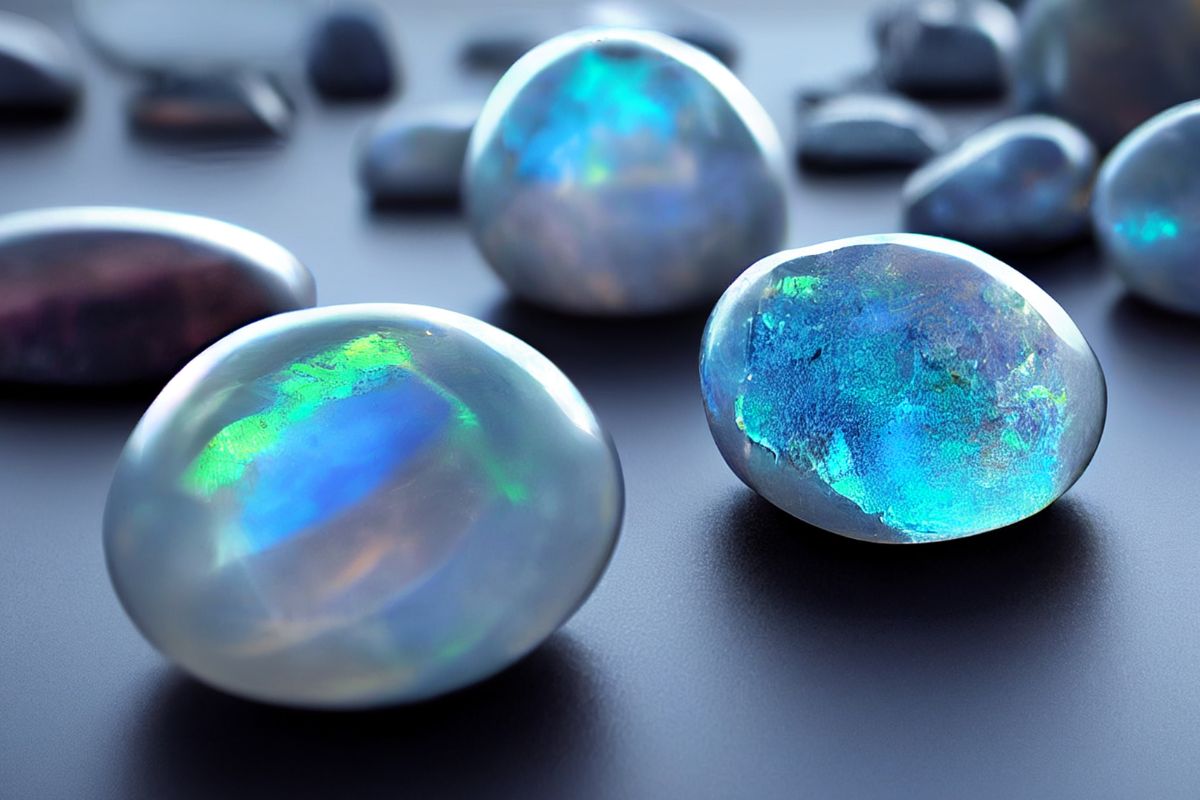
Moonstone and rainbow moonstone offer a fascinating spectrum of colors, providing distinctive appearances that cater to a wide variety of jewelry enthusiasts. Each stone type possesses a unique interplay of colors, influenced by their internal structures and mineral compositions.
Moonstone Color Range
Moonstone, a member of the feldspar group, typically displays a milky or opaque base and is known for its adularescence—a phenomenon that creates a floating blue to white sheen. The color range of moonstone spans from colorless to shades of grey, white, pink, peach, yellow, and green. Its shimmer, which can also include blue or multicolored reflections, contributes to its allure and is especially visible in stones with lighter body colors.
Rainbow Moonstone Hues
Contrary to its name, rainbow moonstone is not a variety of moonstone but rather a trade name for a different feldspar mineral known as labradorite which displays a strong multicolored adularescence. The base color of rainbow moonstone is typically a light to dark grey, and its iridescence can include a spectrum of colors such as vivid blues, greens, and a range of pastel hues. This phenomenon is due to light diffraction within the layers of the mineral, resulting in a dynamic play of colors akin to a rainbow.
Geographical Origins
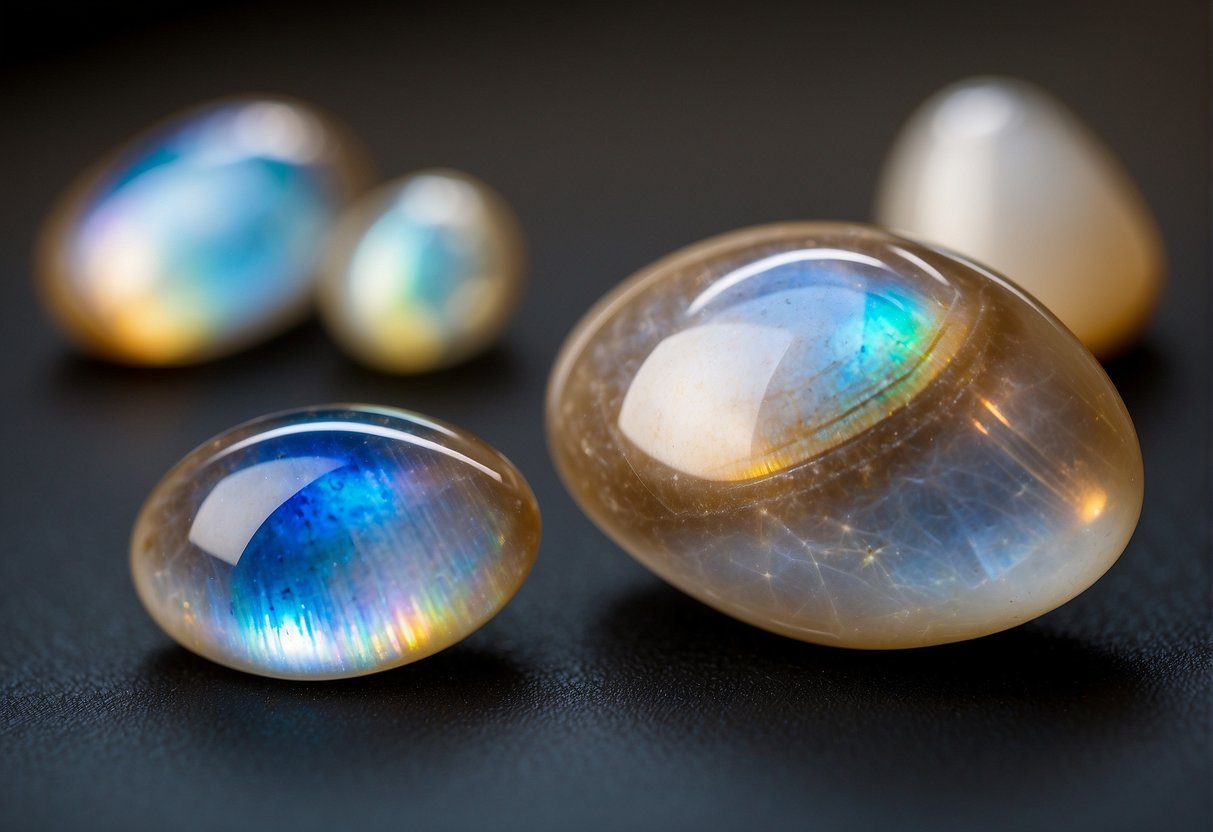
The geological footprint of moonstone and rainbow moonstone is diverse, with each variant having distinct primary locations around the world that are known for their quality and unique characteristics.
Primary Locations for Moonstone
Your search for traditional moonstones leads you to several key locales. Sri Lanka, historically known as Ceylon, is renowned for its high-quality moonstones, aptly named Ceylon moonstones. These moonstones are prized for their blue sheen and translucent body. In India, moonstones are also found with a more subdued appearance but are deeply valued in the local gem market. Venturing to Madagascar, you'll find moonstones that are similar in quality to those from Sri Lanka, with their own unique beauty. The United States, specifically in states like New Mexico, produces moonstones as well, albeit lesser known than their Asian counterparts.
Rainbow Moonstone Sources
When you're on the lookout for rainbow moonstones, you'll primarily be turning your attention to India and Madagascar. Although similar in appearance, rainbow moonstones are not true moonstones but a variety of labradorite, which often leads to confusion. India is at the forefront, offering beautiful specimens with a dark schiller effect. Australia, Brazil, and Myanmar also contribute to the market but to lesser extents. Each region contributes to the broad spectrum of qualities seen in rainbow moonstones, from transparent to opaque, reflecting the diverse geological conditions where they form.
Metaphysical Properties
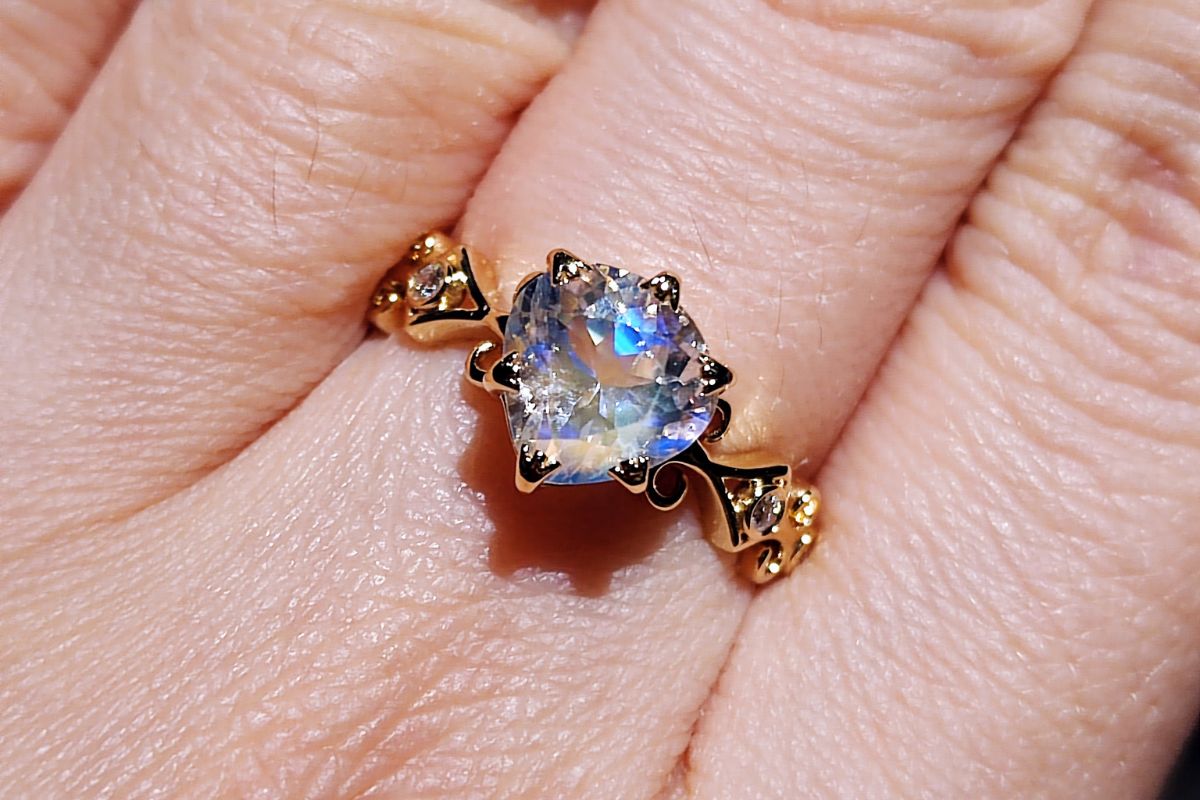
Moonstone and rainbow moonstone carry distinct energetic influences and cultural significance that cater to emotional balance and spirituality. Understanding these aspects can help you appreciate their unique contribution to metaphysical practices.
Energetic Influences
Moonstone is often associated with enhancing intuition and stabilizing emotions. As a gemstone deeply connected to the crown chakra, it is believed to foster spiritual connection and psychic awareness.
- Intuitive Clarity: Believed to clarify intuition, helping you understand your own emotions more clearly.
- Emotional Balance: Supports the achievement of balance in emotional states, promoting a sense of peace.
Rainbow Moonstone, with its play of colors, is said to invoke divine feminine energy. It shares similar properties with moonstone but emphasizes the variety and spectrum of those energetic qualities.
- Feminine Energy: Helps in channeling and amplifying feminine energy, which is often associated with fertility and nurturing.
- Spirituality and Peace: Shown to enhance spiritual growth and inner peace. It's celebrated during the full moon for heightened metaphysical properties.
Cultural Significance
Moonstone and rainbow moonstone carry profound cultural significance across various civilizations, revered not just for their beauty but for their metaphysical properties.
- Peace and Harmony: Culturally, moonstones have been symbols of peace and tranquility.
- Spirituality: These stones are frequently used in spiritual ceremonies to invoke higher consciousness and psychic abilities.
Rainbow Moonstone, with its luminous sheen and spectral light, is often seen as a connection to the mystical and the divine.
- Fertility: It's historically been linked to fertility and the cycles of life, from ancient goddess worship to contemporary spiritual practices.
- Connection with the Divine: Beyond personal spirituality, rainbow moonstone is believed to bridge earthly life with the ineffable.
Your exploration into the metaphysical properties of these gemstones can enrich your understanding and experience of spirituality and emotional harmony.
Moonstone Jewelry and Use
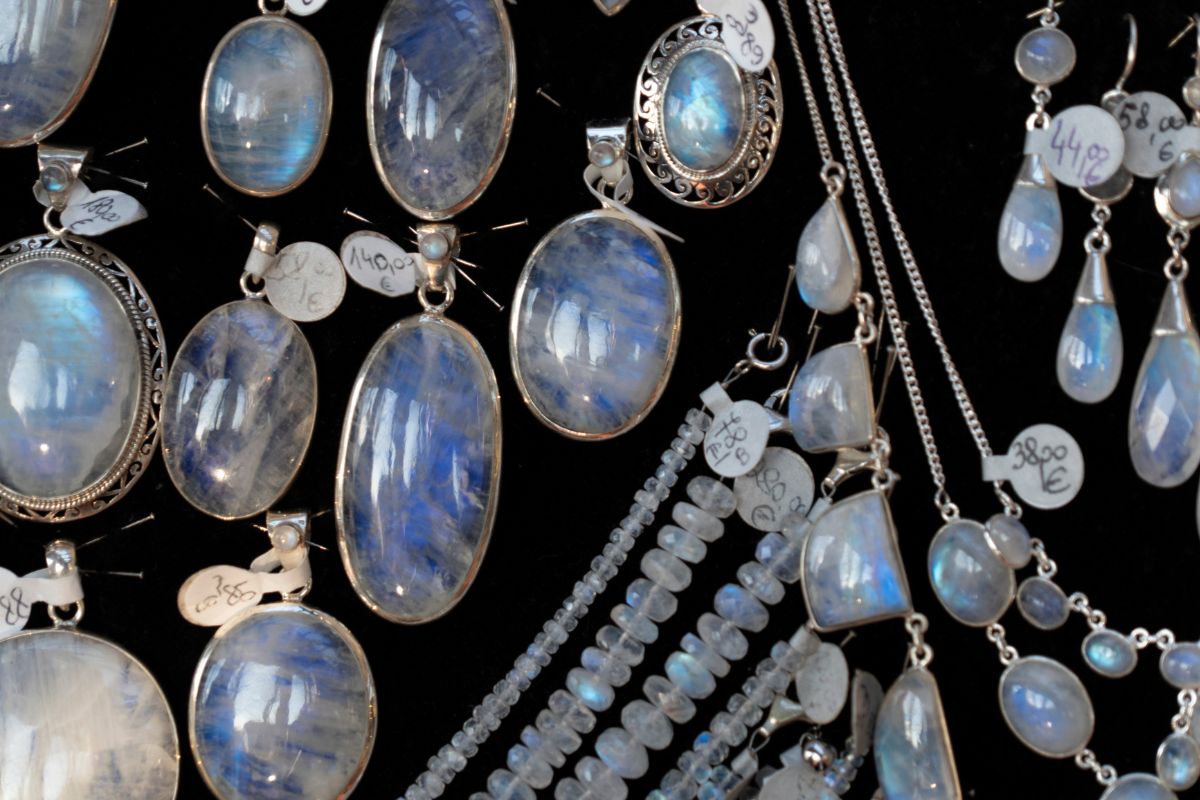
Moonstone and rainbow moonstone are both cherished for their enchanting appearance and are frequently incorporated into various types of jewelry. Understanding their distinctive qualities and common uses in jewelry can greatly enhance your appreciation for these gems.
Cutting and Shaping
Moonstones are typically cut into cabochons, a process that best accentuates their adularescence—the glowing sheen across the surface. A well-executed cabochon cut enhances the visibility of phenomena such as asterism or the cat's eye effect in high-quality specimens. Rainbow moonstone, a trade name for a type of labradorite with a multicolored sheen, is also given a similar treatment to showcase its unique color play.
Popular Types of Jewelry
- Engagement Rings: Both moonstone and rainbow moonstone are becoming increasingly popular in engagement rings due to their unique appearance and symbolism.
- Pendants and Necklaces: The soft glow of these gemstones makes them ideal for pendants that catch the light.
- Earrings and Bracelets: Their versatility extends to earrings and bracelets, adding a subtle elegance.
Moonstone jewelry is appreciated not just for its beauty but also for its perceived spiritual significance, often associated with love, fertility, and intuition.
Inclusions and Their Effects
Moonstones might contain inclusions, such as tiny centipedes or black tourmaline inclusions, which can either detract from or enhance the stone's appearance. In some instances, these inclusions can create an internal landscape, adding character to the gemstone. However, excessive inclusions may reduce the durability and clarity of the moonstone, impacting its suitability for certain types of jewelry.
Market Factors
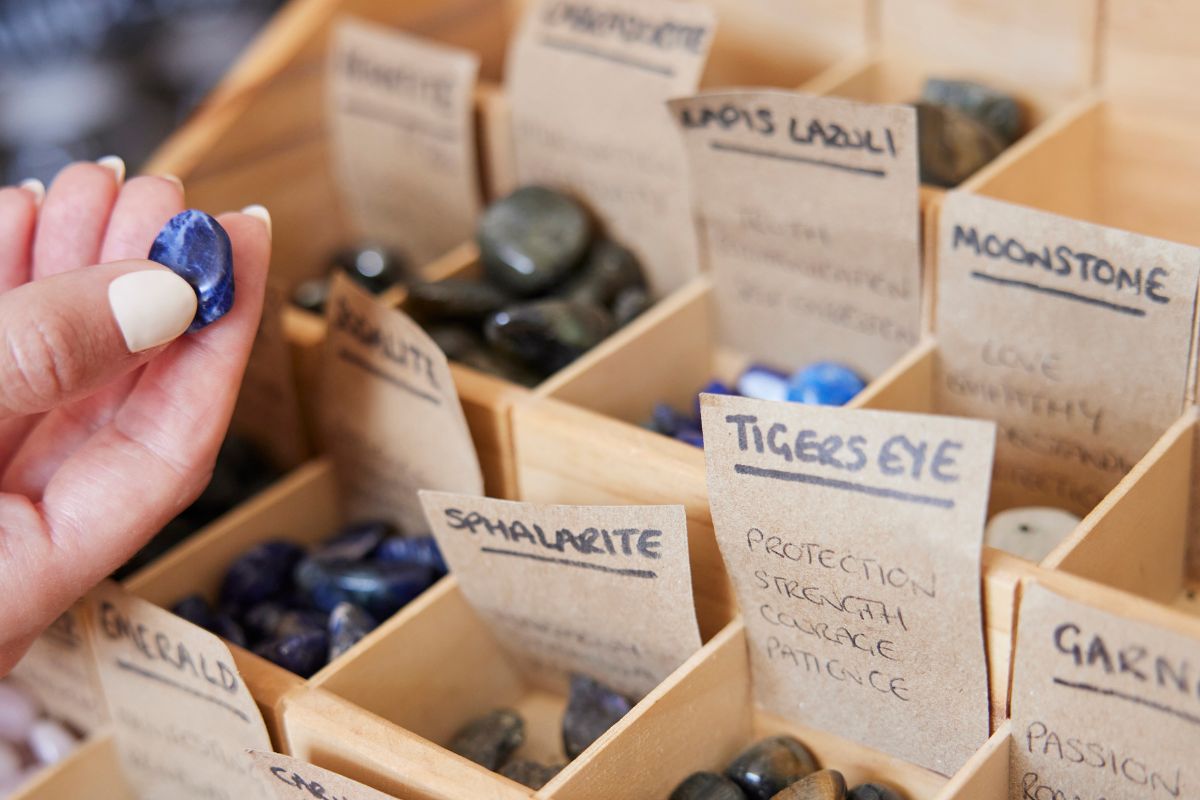
When considering moonstones and rainbow moonstones, it's essential to understand the intricate market factors that sway their value and price.
Determining Value and Price
Moonstones and rainbow moonstones have a layered composition of feldspar minerals that diffract light, creating an enchanting visual effect known as adularescence. This optical phenomenon primarily influences their appeal and, subsequently, their market value. Unlike moonstones, which display a serene white to blue sheen, rainbow moonstones exhibit a prism of colors, akin to opalite, but are entirely natural in their charisma.
Prices for these gemstones are pegged on rarity and quality, with the top-tier rainbow moonstones in sizes over 10 carats fetching higher sums due to their scarcity and striking color play. Finest rainbow moonstones in scarce large carat sizes have been known to command prices as high as fine bluesheen moonstones, an aspect that speaks to the premium that collectors and connoisseurs are willing to pay for exceptional pieces.
Factors such as clarity, cut quality, and origin also play critical roles. Inclusions can deter from the gem's beauty and reduce its price, but some consumers appreciate the unique 'flaws' for their character and personality. A well-executed cut that maximizes the adularescence can amplify the gemstone's allure, boosting its market price.
Moonstones and especially fine quality rainbow moonstones can be more expensive than alternatives like polymer clay creations or opalite, a man-made glass that imitates the color play of precious stones but lacks their natural beauty and durability. The natural allure, durability, and rarity of real moonstones and rainbow moonstones often justify their higher prices in the jewelry market.
Remember, as you shop for these gemstones, the market sets prices reflective of these combined factors, resonating with their innate value and the desirability among enthusiasts.
Frequently Asked Questions
Moonstones captivate with their enchanting shimmer, and understanding the nuances between the various types can enhance your appreciation of these gems. Here's a closer look at some common inquiries.
What are the differences in spiritual meanings between moonstone and rainbow moonstone?
While traditional moonstone is hailed for its connection to feminine energy and intuition, rainbow moonstone is believed to offer enhanced protection, as well as a stronger connection to divine inspiration and esoteric knowledge.
How do moonstone colors, such as white and blue, differ from each other?
The color variations in moonstones, from ethereal white to the intriguing blue sheen, are due to the play of light across the stone's internal structures. White moonstones provide a classic glow, whereas the blue-hued variants often exhibit a more pronounced adularescence or light-scattering effect.
Can rainbow moonstone be distinguished from labradorite and if so, how?
Rainbow moonstone is frequently confused with labradorite due to their similar iridescent qualities. However, you can distinguish them by the former's characteristic pearly sheen and more transparent body, as opposed to labradorite's darker base and full spectrum labradorescence.
What are the meanings attributed to moonstone in various cultures?
Cultures around the world revere moonstone for different reasons: in India, it's a sacred stone linked with dreams and fertility, while in Roman mythology, it's associated with lunar deities, embodying the waxing and waning of the moon.
What is the rarest moonstone color, and why is it considered rare?
Blue moonstone is considered the rarest due to its limited availability. Its scarcity is a result of its unique mineral composition, which yields the coveted blue sheen only under specific conditions during formation.
How can one identify and verify the authenticity of a rainbow moonstone?
To authenticate a rainbow moonstone, examine it for the hallmarks of genuine specimens, such as the characteristic adularescent effect. It’s crucial to assess the stone's transparency, quality of light reflection, and presence of any artificial treatments or enhancements.
Checkout some of our top collections:



